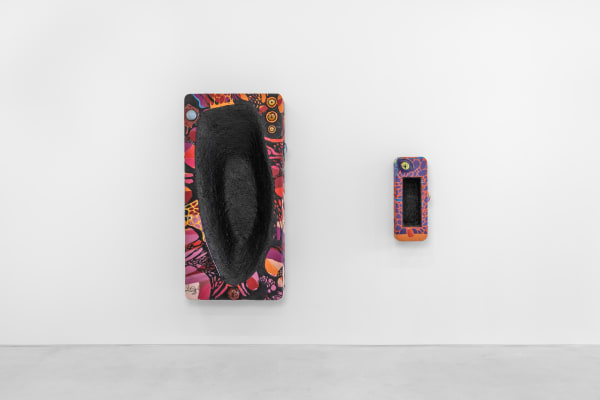Further than Light or Language
Erika Jaeggli’s works in the exhibition are the result of her field research into seven caves in Texas which she explored through photography, videography, LiDAR scanning, as well drawing and writing methods. In this series, her optics offsets the tradition of landscape painting in which a singular point of view translated to dominion and ownership of the land. Jaeggli’s representations of raw, interior spaces of underground formations offer multiple points of view and entry through which to consider the land. “While cave entrances have defined boundaries, the space beneath the surface does not,” she notes. She seals her photographic collages with liquified encaustic layers which, upon hardening, point to gravity and time of cave formations. Jaeggli’s paintings highlight the darkness of a cave as a spectatorial condition, which triggers guttural response and prompts the reverse movement in time.
In Abi Shehu’s installation ‘see, once more, the stars’ the cave becomes the lens into familial histories. Capturing the caves of Vjosa River in Albania on black and white film, the artist clings to a story of her father’s attempted escape from the communist dictatorship regime of Enver Hoxha. Vjosa, a river flowing from the mountains in Greece to the Adriatic coast in Albania, is one of the last wild rivers in Europe, known for its underground passages and uncharted caves. Shehu portrays these underworld sites as a Dantesque hell, weaving her personal evocations into a larger narrative about mass migration process triggered by Hoxha’s autocracy, where fugitives’ routes despairingly developed in the direction opposite to the river flow. The monochrome photograph of subterranean textures covered in desiccated webs of water drips offers itself as a sublime plane to gaze into, in search of familiar contours and shapes. Surrounded by sculpted serpents with grotesque mouths and some missing teeth, the installation is a symbolic representation of the artist’s father’s intercepted escape attempt. Darkness nevertheless remains a potent space for survival in the artist’s mythology, a space for the cultivation of attentive vision. Darkness challenges the knowledge of routes – whether these are the routes of escape, foraging or transmission.
Life next to death under the conditions of condensed time is a recurring theme in Sana Shahmuradova-Tanska’s work produced during Russia’s war in Ukraine at the background. Human-resembling figures in her recent paintings no longer hold their sturdy shapes but rather dissolve and morph into new forms. Like moving magma, these bodies in her compositions breathe out aspirations and exhaustion. The emphatic illegibility of Shahmuradova’s plots, which are built out of restrained visual vocabulary of recognizable elements such as human faces and bodies, explodes in the end with dozens of conceptual elements that refer to paranormal.
The motif of an eye peeking through clouds of smoke and sand dust, or an eye implanted into palm hollers across the paintings signifying tactility, skin’s perceptual apparatus, and the irreplaceable need to touch the other. The illegibility of Shahmuradova’s visual language is the product of density, where memories get reanimated and emotions are articulated in their purest form. Her canvas become the textures of the wound, housing within itself complex human physiology and the adamant attempts to grapple with the evolutionary stages of civilizational development.
Pedro Wirz presents wall reliefs with wound-like cavities, adorned by the fragmented depictions of birds and animal bodies along the edges of these nearly human-sized objects. Wirz’s colorful elaborate work carries references to his upbringing in the tropical Paraiba Valley in Brazil, bridging the artist’s critical look at the aggressive urbanization with his fascination in local folklore and lush material culture. Wall reliefs by Wirz with wound-like cavities, adorned by the fragmented depictions of birds and animal bodies along the edges of these nearly human-sized objects. Looking for meaning amidst the ongoing social clashes and changing ecologies, the extinction and renewal remain two key parameters to watch closely. The wound-like shape in Sadnest wall relief performs better as a volcano crater where an end of one flesh signifies the new beginning for another life form and ecosystems. As a dialectical inversion to other works in the show, Wirz’s wall relief evokes the shape of a hyperbolic smartphone – a prosthetic, synthetic cave of the contemporary screen dominated landscape, which is crucial to remember when it comes to technology’s exploitative power and human attention fracking.
Where are we on a path from ignorance to knowledge, from illusion to reality? And what purpose does light serve in our sinking spaces? Among many things, this exhibition is an exploration of human vision entangled into complex legal, political and media apparatuses. This show keeps the apertures open, letting the gaze descend into sometimes uncomfortable mental spaces. The darkness of a bomb shelter, the darkness of technological gadgets, the unknowns of human physiology and psyche, the darkness of a sheltering cave. Where does the water flow..?
Exhibition curated by Lilia Kudelia.










